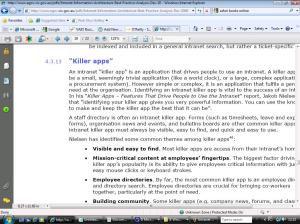As one of the softer web disciplines that lies at the heart of Microsoft SharePoint as a software product and its central importance in the implementation of countless solutions, I have read a lot of articles and book chapters about SharePoint that stress the importance of “getting your information architecture right”.
The quality of this thinking is not always quite what it might be. The analysts at Forrester, for instance, tell us (seemingly with great authority):
SharePoint buyers expect intuitive navigation, contextual search, and easy administration out of the box. But such benefits depend on how content is structured, labeled, and categorized, and they require a nuanced understanding of how different audiences will navigate and search for information.
The information architecture (IA) behind a SharePoint deployment has lasting consequences for the end user experience and for Web site management. Information and knowledge management (I&KM) professionals should use their SharePoint implementations as an opportunity to set solid information architecture in place that turns today’s information overload into tomorrow’s valuable information assets.
The upshot?
Information workers will finally be able to find the critical information they need to do their jobs.
(See Forrester: The Critical Role of SharePoint Information Architecture, http://blogs.msdn.com/architectsrule/archive/2009/02/26/forrester-the-critical-role-of-sharepoint-information-architecture.aspx)
Ok … so far, so good, but where exactly does this get us?
Town Planning…

Town Planning (© things magazine)
In early 1998 Louis Rosenthal and Peter Morville made their name in publishing a bestselling book entitled Information Architecture for the World Wide Web (now in its Third Edition!).
As a newly appointed e-business consultant working for The iGroup at Computercenter in London, I remember avidly reading their – essentially very simple – book and thinking “Wow, these guy’s have got it right!”
Switch to mid 2009 and inevitably the practice of building websites is far more sophisticated, and hopefully I am little less naïve than I used to be.
Superficially, at least, it seems that those professionals who devote their lives to working on the web are now much more qualified to provide a sophisticated response to the question of what makes a “perfect” information architecture. One that takes into account so-called “best practice” in emergent web disciplines as diverse as needs analysis, stakeholder and user audience profiling, content analysis, information science and classification, usability and accessibility, wire-framing, web and user interface design.
Yet growing sophistication in the field comes with a price.
Quite simply, it is very hard for a busy web professional – and I include myself in this category – to have a genuine appreciation of all these burgeoning web disciplines to allow true mastery over the undoubted “art” of information architecture.
In my personal view, therefore, the vast majority of those who construct information architectures for a living are informed not by a deep understanding (of a myriad of web sub-disciplines), but rather by a mix of unvalidated opinions, their personal preferences, and a partial understanding of their trade.
In the City of Organised Thought
What of the subject matter of the information architects – the websites, extranets and intranets?
Essentially, all these forms of “web patterns” reflect human activity in all of its diversity. This relationship is undoubtedly an organic thing that both evolves overtime and exhibits great complexity.
Think, for instance, of an Intranet that must by necessity reflect an organisation’s ever changing social, political and informational life, and you realise that this is indeed a complex undertaking. Likewise, a website that marries a particular content focus with this or that user audience – the latter always demanding, whoever they are.
As such, these generic “web patterns” are capable of order and structure – indeed in many ways they exhibit and need such order – but the kinds of order that are possible vary enormously even within the same general setting.
Sure, these different kinds of order may be related as “patterns”, but equally they cannot be mutually reduced except by gross simplification.
Recognition of this awkward fact – i.e. a singular lack of neatly tended streets in our metaphor – also tends to be fiercely resisted by professionals who are engaged in theoretical system building both to justify their profession and the need to prove that they “know their stuff”.
And because they have succeeded in introducing an impressive kind of order they are always tempted to extend it more widely than they should. In effect, they have formulated a neat and tidy “theory” and as such want to place that above all others.

Cityscape (© CGZool)
It is as though they have the ambition of knocking down the irregular and awkward city streets that disrupt their thinking, and rebuilding them to their vision – with a strong preference for unfailing regularity in both architectural design and pathways.
Beware the Despotic Pattern with SharePoint
What then are some general pitfalls in town planning with SharePoint Products and Technologies?
First, there is the ever present tension of dealing with a software product in solution design. It is obvious that the very fact that SharePoint is a product both structures and constrains your thinking in relation to the practice of information architecture.
And while there is little doubt that MOSS 2007 as a CMS has an elegant hierarchical model enshrined in its Content Database structure:
Yet MOSS is known to be hard to customise….
As a consequence this model tends to impart a strong solution preference in formulating an IA within SharePoint. Effectively, out of the box MOSS 2007 – in either its Publishing or Collaboration Portal mode – will do what it wants to do very well indeed; but it is not quite so good when your architectural design does not conform to SharePoint’s particular blueprint.
There is, therefore, no doubt that it is very easy to lose honesty very quickly in the overwhelming desire to avoid the pain of customising SharePoint to meet a requirement for implementing even a moderately awkward neighbourhood.
Try, however, to resist the lure of this particular siren!
As we have discovered at Storm just recently there are some very real benefits in remaining honest. This being due in the main to the technical brilliance of my colleagues – in particular Tom Travers – who have succeeded in opening up MOSS 2007 to customisation in a number of different areas. Town planning being one of them.
Second, beware Greeks that bear false gifts… and retain a healthy skepticism towards the town planners of this particular product (i.e. the SharePoint analysts that solemnly tell you how to formulate that perfect IA). Telling is one thing; doing is quite another. Thus, treat with caution – though clearly don’t dismiss – their formulas and pronouncements as they relate to the complex and difficult task of town planning.
And, finally, never lose sight of the fact that in constructing an IA – regardless of whether it is for SharePoint or not – there is no substitute for deep understanding, imagination, and, yes, a lot of hard work.
Note: This post is the first of an occasional series that attempts to explore the discipline of information architecture in relation to SharePoint. And my advance apologies if this first post mentions relatively little about SharePoint! I am simply trying to explain how I see the landscape of the discipline before turning my attention to SharePoint proper.
Read Full Post »

 Anyway, the tradition continues to burn bright in the publication of Intranet Information Architecture: Best Practices Analysis (from the e-Government Resource Centre, Victoria State Government, Australia, December 2008).
Anyway, the tradition continues to burn bright in the publication of Intranet Information Architecture: Best Practices Analysis (from the e-Government Resource Centre, Victoria State Government, Australia, December 2008).





